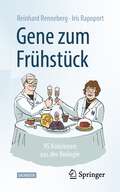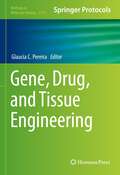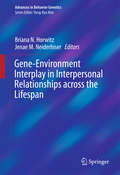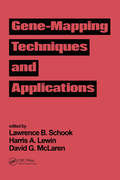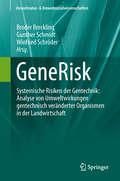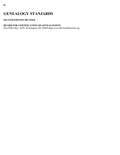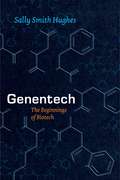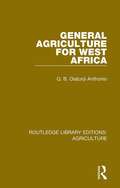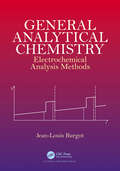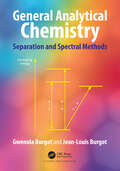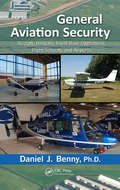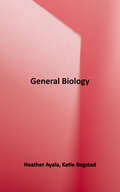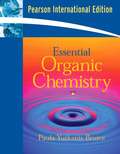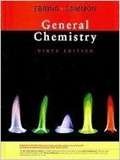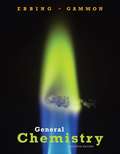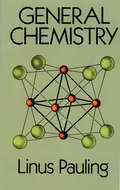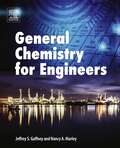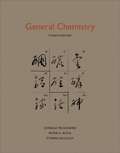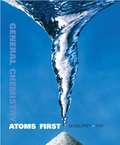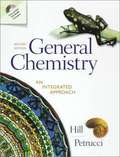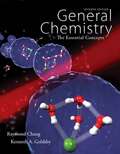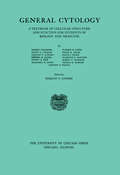- Table View
- List View
Gene zum Frühstück: 95 Kolumnen aus der Biologie
by Reinhard Renneberg Iris RapoportDie Autoren entführen uns auch in ihrem neuen Werk in die spannende und vielfältige Welt der Biochemie und Biotechnologie. Das Buch befasst sich mit einer Vielzahl interessanter Fragen und Fakten. Gentechnik – darf man das, soll man das oder muss man das? Die Autoren spüren dem Traum vom Jungbrunnen nach und versuchen Paganinis Geheimnis zu lüften. Sie verblüffen uns, wo alte Handarbeitstechniken plötzlich gefragt sind oder giftige Skorpione sich nützlich machen. Geschrieben in Zeiten, in denen Corona uns beutelt, wurden unsichtbare Feinde, und wie wir uns gegen sie wehren, natürlich nicht ausgespart. Nebenbei wird auch geklärt, was brauner Haut und buntem Obst gemeinsam ist, wie Vitamine in den Kuchen kommen und worin Monets Tragik bestand.
Gene, Drug, and Tissue Engineering (Methods in Molecular Biology #2575)
by Glaucia C. PereiraThis book combines discursive chapters that present the latest progress in molecular biology, drug discovery, organ-tissue engineering, and related fields, with a number of descriptive chapters on methods, protocols, and case studies. Structured into four parts, this volume walks the reader through the latest in cellular biology, with discussions on novel medicinal plant metabolites, nanotechnology in precision medicine, nucleic acid-based therapeutics and vaccines, genetic engineering, computational aid, bioinformatics, synthetic organs for transplantation, and organ-tissue engineering. Written for the highly successful Methods in Molecular Biology series, chapters include the kind of detail and expert implementation advice that ensures quality results in the lab. Authoritative and informative, Gene, Drug, and Tissue Engineering serves as an ideal guide for undergraduate students, postgraduate researchers, and senior researchers working in biomedicine and its underlying technologies, stimulating both computational and experimental development and fostering the exchange of new ideas.
Gene-Environment Interplay in Interpersonal Relationships across the Lifespan
by Briana N. Horwitz Jenae M. NeiderhiserIntriguing new findings on how genes and environments work together through different stages of life take the spotlight in this significant collection. Studies from infancy to late adulthood show both forces as shaping individuals' relationships within family and non-family contexts, and examine how these relationships, in turn, continue to shape the individual. Transitional periods, in which individuals become more autonomous and relationships and personal identities become more complicated, receive special emphasis. In addition, chapters shed light on the extent to which the quantity and quality of genetic and environmental influence may shift across and even within life stages. Included in the coverage: Gene-environment interplay in parenting young children. The sibling relationship as a source of shared environment. Gene-environment transactions in childhood and adolescent problematic peer relationships. Toward a developmentally sensitive and genetically informed perspective on popularity. Spouse, parent, and co-worker: roles and relationships in adulthood. The family system as a unit of clinical care: the role of genetic systems. Behavioral geneticists, clinical psychologists, and family therapists will find in Gene-Environment Interplay in Interpersonal Relationships across the Lifespan a window into current thinking on the subject, new perspectives for understanding clients and cases, and ideas for further study.
Gene-Mapping Techniques and Applications
by Lawrence B. Schook Harris A. Lewin David G. McLarenThis book explains current strategies for mapping genomes of higher organisms and explores applications of gene mapping to agriculturally important species of plants and animals. It also explores the experimental techniques used for genetic and physical mapping of genes.
GeneRisk
by Broder Breckling Winfried Schröder Gunther SchmidtDas Buch gibt einen Einblick in systemische Verknüpfungen, denen der Anbau von gentechnisch veränderten Pflanzen in Deutschland unterliegen würde. Es thematisiert Verknüpfungen, die sich zwischen ökologischen und sozialen Systemzusammenhängen herstellen lassen. Bisherige Betrachtungen widmeten sich dem Thema entweder aus ökologischer Perspektive oder thematisieren (agrar-)politische Zusammenhänge. Das Buch resultiert aus einem Forschungsprojekt, in welchem das BMBF die Erforschung sozialökologischer Wechselwirkungen gefördert hat.
Genealogy Standards
by Board for Certification of GenealogistsHow do family historians know they are producing or receiving trustworthy results? This official manual from the Board of Certification for Genealogists, essentially a users' guide for family historians, provides standards for genealogical researchers to assess their own and others' work. <p><p>The revised second edition increases the clarity of DNA and privacy standards. Those standards are especially useful in the twenty-first century, when many genealogists use a complex new tool―DNA testing―and trace living people more often than they did in the past.
Genentech: The Beginnings of Biotech
by Sally Smith HughesIn the fall of 1980, Genentech, Inc. , a little-known California genetic engineering company, became the overnight darling of Wall Street, raising over $38 million in its initial public stock offering. Lacking marketed products or substantial profit, the firm nonetheless saw its share price escalate from $35 to $89 in the first few minutes of trading, at that point the largest gain in stock market history. Coming at a time of economic recession and declining technological competitiveness in the United States, the event provoked banner headlines and ignited a period of speculative frenzy over biotechnology as a revolutionary means for creating new and better kinds of pharmaceuticals, untold profit, and a possible solution to national economic malaise. Drawing from an unparalleled collection of interviews with early biotech players, Sally Smith Hughes offers the first book-length history of this pioneering company, depicting Genentech's improbable creation, precarious youth, and ascent to immense prosperity. Hughes provides intimate portraits of the people significant to Genentech's science and business, including cofounders Herbert Boyer and Robert Swanson, and in doing so sheds new light on how personality affects the growth of science. By placing Genentech's founders, followers, opponents, victims, and beneficiaries in context, Hughes also demonstrates how science interacts with commercial and legal interests and university research, and with government regulation, venture capital, and commercial profits. Integrating the scientific, the corporate, the contextual, and the personal, Genentech tells the story of biotechnology as it is not often told, as a risky and improbable entrepreneurial venture that had to overcome a number of powerful forces working against it.
General Agriculture for West Africa (Routledge Library Editions: Agriculture #13)
by Q.B. Olatunji AnthonioFirst published in 1979. This study examines various aspects of agriculture in West Africa. There is a strong chapter on the economics of agriculture and records, farm machinery, agricultural improvement, fish and the basics of crop and livestock production are all dealt with. The role of government policy in the improvement of agriculture is also examined. This title will be useful to undergraduates concerned with agriculture who want a good grounding before going on to their specialised fields of the applied sciences, as well as to those interested in commercial farming and policy makers in civil administration.
General Analytical Chemistry: Electrochemical Analysis Methods
by Jean-Louis BurgotThis book is devoted to the quantitative electrochemical methods of analysis in solution. A theoretical knowledge of each method is discussed. The methods are illustrated with several examples covering a wide range of types of analysis. The book is divided in three parts. The first one is introductory. It recalls some definitions and some basic concepts of electrochemistry. The second part describes the methods themselves. Are studied voltametric methods, amperometry, potentiometry, conductometry, the electrogravimetry and coulometry. Some chapters are also dedicated to the chemical and electrochemical sensors. The third part consists in a supplementary theoretical knowledge of each method.
General Analytical Chemistry: Separation and Spectral Methods
by Jean-Louis Burgot Gwenola BurgotThis book provides key information about the instrumental analytical methods which are the most used in quantitative analysis. A theoretical knowledge of each method is discussed. The methods are illustrated with several examples covering a wide range such as pharmacy, biochemical, environmental and agrochemicals analysis. It is structured into three parts: the first one focuses on separation methods, the second covers the spectroscopic ones and the third part develops the thermal and the radiochemical methods.
General Aviation Security: Aircraft, Hangars, Fixed-Base Operations, Flight Schools, and Airports
by Ph.D, Daniel BennyAfter 9/11, the initial focus from the U.S. government, media, and the public was on security at commercial airports and aboard commercial airlines. Soon, investigation revealed the hijackers had trained at flight schools operating out of general aviation airports, leading to a huge outcry by the media and within the government to mandate security
General Biology
by Heather Ayala Katie RogstadGeneral Biology, Novare's high school biology text, combines up-to-date science with a Christian worldview as well as the mastery-based educational philosophy for which Novare is known. <p><p>Chapters start at the atomic level and progress to ever-larger scales: cells, genes, microorganisms, plants, animals, and human organ systems. Each chapter includes straightforward learning objectives, exercises that call for both the clear articulation of thoughts and full-sentence answers, and an organization of topics that steadily builds. The final chapters of the book survey ecology and the theory of evolution. <p><p>Like all Novare texts, mastery-based learning methods are an essential part of General Biology, propelling students not only to learn but also to substantially retain the content for years after completing the course. The book succinctly and logically covers a wide array of information in a modest number of pages. Vivid, appealing graphics draw students into mature engagement with the content. 536 pages, hardcover. Grade 10-12.
General Chemistry
by Bruce Averill Patricia EldredgeThe overall goal of the authors with General Chemistry: Principles, Patterns, and Applications was to produce a text that introduces the students to the relevance and excitement of chemistry. Although much of first-year chemistry is taught as a service course, Bruce and Patricia feel there is no reason that the intrinsic excitement and potential of chemistry cannot be the focal point of the text and the course. So, they emphasize the positive aspects of chemistry and its relationship to students’ lives, which requires bringing in applications early and often. In addition, the authors feel that many first year chemistry students have an enthusiasm for biologically and medically relevant topics, so they use an integrated approach in their text that includes explicit discussions of biological and environmental applications of chemistry. Topics relevant to materials science are also introduced to meet the more specific needs of engineering students.
General Chemistry
by Bruce Averill Patricia EldredgeThe overall goal of the authors with General Chemistry: Principles, Patterns, and Applications was to produce a text that introduces the students to the relevance and excitement of chemistry. Although much of first-year chemistry is taught as a service course, Bruce and Patricia feel there is no reason that the intrinsic excitement and potential of chemistry cannot be the focal point of the text and the course. So, they emphasize the positive aspects of chemistry and its relationship to students' lives, which requires bringing in applications early and often. In addition, the authors feel that many first year chemistry students have an enthusiasm for biologically and medically relevant topics, so they use an integrated approach in their text that includes explicit discussions of biological and environmental applications of chemistry. Topics relevant to materials science are also introduced to meet the more specific needs of engineering students.
General Chemistry
by Steven D. Gammon Darrell EbbingGENERAL CHEMISTRY is better than ever with this eleventh edition. It includes essential updates--such as modern artwork, higher integration with OWLv2, revised end-of-chapter questions, added Capstone Problems, narrative revisions, and more--to help you succeed in your chemistry course.
General Chemistry
by Linus Pauling"An excellent text, highly recommended." -- ChoiceWhen it was first published, this first-year chemistry text revolutionized the teaching of chemistry by presenting it in terms of unifying principles instead of as a body of unrelated facts. Those principles included modern theories of atomic and molecular structure, quantum mechanics, statistical mechanics and thermodynamics. In addition, Dr. Pauling attempted to correlate the theories with descriptive chemistry, the observed properties of substances, to introduce the student to the multitude of chemical substances and their properties. In this extensively revised and updated third edition, the Nobel Prize-winning author maintains an excellent balance between theoretical and descriptive material, although the amount of descriptive chemistry has been decreased somewhat, and the presentation of the subject, especially in relation to the nonmetals, has been revised in such a way as to permit greater correlation with the electronic structure of atoms, especially electronegativity.The principles of quantum mechanics are discussed on the basis of the de Broglie wavelength of the electron. The quantized energy levels of a particle in a box are derived by means of a simple assumption about the relation of the de Broglie waves to the walls of the box. No attempt is made to solve the Schrodinger wave equation for other systems, but the wave functions of hydrogen-like electrons are presented and discussed in some detail, and the quantum states for other systems are also covered. Statistical mechanics is introduced before thermodynamics, and the discussion of thermodynamics is based on it. This arrangement reflects the author's belief that beginning students can understand statistical mechanics better than chemical thermodynamics.Aimed at first-year college students who plan to major in chemistry or closely related fields, the book is written in a logical, clear and understandable style. In addition, many excellent figures are included, along with numerous problems and 75 pages of appendixes covering such topics as symmetry of molecules and crystals, hybrid bond orbitals, and magnetic properties of substances.
General Chemistry (AP Edition)
by Darrell D. Ebbing Steven D. GammonKnown for its carefully developed, thoroughly integrated approach to problem solving, this market-leading text emphasizes the conceptual understanding and visualization skills essential for first-year chemistry and science majors. The new technology program reinforces the approach of the text and provides a complete solution for teaching and learning.The Eighth Edition retains the hallmark pedagogical features of the text and builds upon the conceptual focus and art program. Students also benefit from online homework in the technology program, which features an extensive database of questions drawn from the text.In order to reinforce major chemical concepts, the authors present a proven six-part approach to problem solving that includes Example, Problem Strategy, Solution, Answer Check, Exercise, and corresponding End-of-Chapter Problems, many of which are presented in matched pairs.
General Chemistry Experiments
by Anil J. EliasThis novel collection of twenty-two experiments, covering all areas of practical chemistry, has been introduced for the chemistry courses of Indian Institute of Technologies and other institutions where chemistry is taught at undergraduate level.
General Chemistry for Engineers
by Jeffrey Gaffney Nancy MarleyGeneral Chemistry for Engineers explores the key areas of chemistry needed for engineers. This book develops material from the basics to more advanced areas in a systematic fashion. As the material is presented, case studies relevant to engineering are included that demonstrate the strong link between chemistry and the various areas of engineering. - Serves as a unique chemistry reference source for professional engineers - Provides the chemistry principles required by various engineering disciplines - Begins with an 'atoms first' approach, building from the simple to the more complex chemical concepts - Includes engineering case studies connecting chemical principles to solving actual engineering problems - Links chemistry to contemporary issues related to the interface between chemistry and engineering practices
General Chemistry, 4th Edition
by Donald A. Mcquarrie Peter A. Rock Ethan B. Gallogly University Science Books StaffThis new fourth edition of General Chemistry takes an atoms-first approach from beginning to end. In the tradition of McQuarrie's many previous works, it promises to be another ground-breaking text. This superb new textbook combines the clear writing and wonderful problems that have made McQuarrie famous among chemistry professors and students worldwide. Presented in an elegant design with all-new illustrations, it is available in a soft-cover edition to offer professors a fresh choice at an outstanding value. Student supplements include an online series of descriptive chemistry Interchapters, a Students Solutions Manual, and an optional state-of-the-art Online Homework program. For adopting professors, an Instructor's Manual and a CD of the art are also available. NOT AVAILABLE IN NORTH AMERICA AND CANADA "McQuarrie is a genius. " Harry Gray, Caltech "Atoms First seems to be the flavor of the year in chemistry textbooks, but many of them seem to be little more than rearrangement of the chapters. It takes a master like McQuarrie to go back to the drawing board and create a logical development from smallest to largest that makes sense to students. " Hal Harris, University of Missouri-St Louis "McQuarrie's book is extremely well-written, the order of topics is logical, and it does a great job with both introductory material and more advanced concepts. Students of all skill levels will be able to learn from this book. " Mark Kearley, Florida State University
General Chemistry: An Atoms-first Approach
by John E. Mcmurry Robert C. FayThis text tells a cohesive story about chemistry that follows an intuitive logic by progressing from the simplest building blocks to successively more complex concepts. It follows a unified thread of ideas that help students build a better foundation and ultimately gain a deeper understanding.
General Chemistry: An Integrated Appraoch
by John William Hill Ralph H. PetrucciMore than any other, this book offers balance - in the topics presented, in its approach to problem solving, and in its presentation of the subject of chemistry. Integrated coverage of organic and biochemistry; integrated applications; integrated tools that foster operational problem-solving and conceptual understanding; and an integrated media learning program. Expanded coverage of key chemistry topics such as organic chemistry, biochemistry, material science, and environmental chemistry.
General Chemistry: The Essential Concepts
by Raymond Chang Kenneth GoldsbyThe seventh edition of General Chemistry continues the tradition of presenting only the material that is essential for a one-year general chemistry course. It strikes a balance between theory and application by incorporating real-world examples; helping students visualize the three-dimensional atomic and molecular structures that are the basis of chemical activity; and developing problem-solving and critical thinking skills. Although the seventh edition incorporates many impressive features, such as conceptual idea review, animations correlated to the text, and hand-sketched worked examples, General Chemistry is still 200 to 300 pages shorter and much less expensive than other two-semester textbooks. Dr. Chang and Dr. Goldsby’ concise-but-thorough approach will appeal to efficiency-minded instructors and value-conscious students.
General Cytology: A Textbook of Cellular Structure and Function for Students of Biology and Medicine
by Edmund V. CowdryThis volume was, at the time of publication, the largest and most comprehensive book on the subject of cytology, a branch of zoology which had grown considerably in the years before 1924. It was written by the foremost cytologists in the United States, including Robert Chambers, Edwin G. Conklin, Edmund V. Cowdry, Merle H. Jacobs, Ernest E. Just, Margaret R. Lewis, Warren H. Lewis, Frank R. Lillie, Ralph S. Lillie, Clarence E. McClung, Albert P. Mathews, Thomas H. Morgan, and Edmund B. Wilson.
